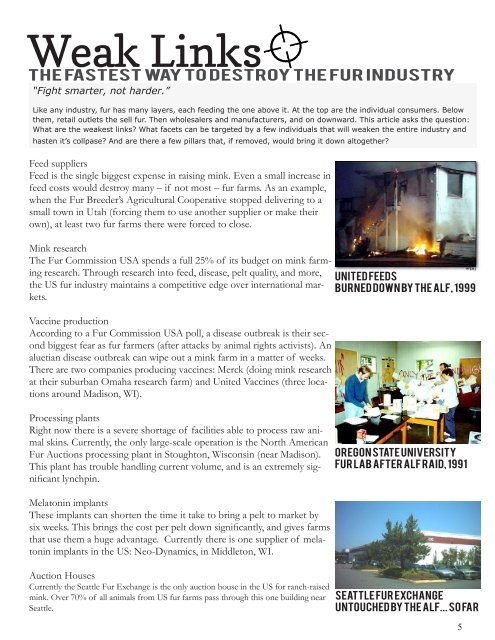You also want an ePaper? Increase the reach of your titles
YUMPU automatically turns print PDFs into web optimized ePapers that Google loves.
Weak Links<br />
The fastest way to Destroy the Fur Industry<br />
“Fight smarter, not harder.”<br />
Like any industry, fur has many layers, each feeding the one above it. At the top are the individual consumers. Below<br />
them, retail outlets the sell fur. Then wholesalers and manufacturers, and on downward. This article asks the question:<br />
What are the weakest links? What facets can be targeted by a few individuals that will weaken the entire industry and<br />
hasten it’s collpase? And are there a few pillars that, if removed, would bring it down altogether?<br />
Feed suppliers<br />
Feed is the single biggest expense in raising mink. Even a small increase in<br />
feed costs would destroy many – if not most – fur farms. As an example,<br />
when the Fur Breeder’s Agricultural Cooperative stopped delivering to a<br />
small town in Utah (forcing them to use another supplier or make their<br />
own), at least two fur farms there were forced to close.<br />
Mink research<br />
The Fur Commission USA spends a full 25% of its budget on mink farming<br />
research. Through research into feed, disease, pelt quality, and more,<br />
the US fur industry maintains a competitive edge over international markets.<br />
Vaccine production<br />
According to a Fur Commission USA poll, a disease outbreak is their second<br />
biggest fear as fur farmers (after attacks by animal rights activists). An<br />
aluetian disease outbreak can wipe out a mink farm in a matter of weeks.<br />
There are two companies producing vaccines: Merck (doing mink research<br />
at their suburban Omaha research farm) and United Vaccines (three locations<br />
around Madison, WI).<br />
Processing plants<br />
Right now there is a severe shortage of facilities able to process raw animal<br />
skins. Currently, the only large-scale operation is the North American<br />
Fur Auctions processing plant in Stoughton, Wisconsin (near Madison).<br />
This plant has trouble handling current volume, and is an extremely significant<br />
lynchpin.<br />
Melatonin implants<br />
These implants can shorten the time it take to bring a pelt to market by<br />
six weeks. This brings the cost per pelt down significantly, and gives farms<br />
that use them a huge advantage. Currently there is one supplier of melatonin<br />
implants in the US: Neo-Dynamics, in Middleton, WI.<br />
Auction Houses<br />
Currently the Seattle Fur Exchange is the only auction house in the US for ranch-raised<br />
mink. Over 70% of all animals from US fur farms pass through this one building near<br />
Seattle.<br />
United Feeds<br />
Burned down by the ALF, 1999<br />
Oregon State University<br />
Fur Lab After ALF raid, 1991<br />
Seattle Fur Exchange<br />
Untouched by the ALF... So far



